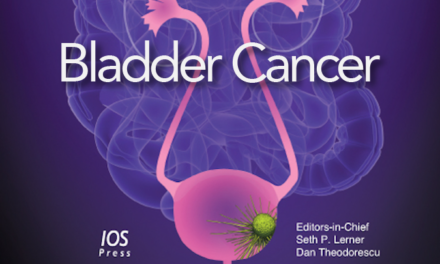Dr. Erik Castle spoke at the 23rd annual Perspectives in Urology Point • Counterpoint meeting on Friday, November 14, 2014 on “Increasing Role of Biomarkers for Prostate Cancer and Bladder Cancer Detection.”
Presentation
Keywords: biomarkers, prostate cancer, bladder cancer, Prostate Health Index (PHI), cytology
How to cite: Castle, Erik P. “Increasing Role of Biomarkers for Prostate Cancer and Bladder Cancer Detection” Grand Rounds in Urology. June 23, 2015. Accessed Nov 2024. https://dev.grandroundsinurology.com/bladder-cancer-erik-castle-biomarkers/.
References
Fradet Y, Lockhard C. Performance characteristics of a new monoclonal antibody test for bladder cancer: ImmunoCyt trade mark. Can J Urol. 1997 Sep;4(3):400-405.
http://www.ncbi.nlm.nih.gov/pubmed/12735818
Friedrich MG, Hellstern A, Toma MI, et al. Are false-positive urine markers for the detection of bladder carcinoma really wrong or do they predict tumorrecurrence? Eur Urol. 2003 Feb;43(2):146-50; discussion 150-1.
http://www.ncbi.nlm.nih.gov/pubmed/12565772
Halling KC. Vysis UroVysion for the detection of urothelial carcinoma. Expert Rev Mol Diagn. 2003 Jul;3(4):507-19.
http://www.ncbi.nlm.nih.gov/pubmed/12877389
Halling KC, King W, Sokolova IA, et al. A comparison of BTA stat, hemoglobin dipstick, telomerase and Vysis UroVysion assays for the detection ofurothelial carcinoma in urine. J Urol. 2002 May;167(5):2001-6.
http://www.ncbi.nlm.nih.gov/pubmed/11956427
Karakiewicz PI, Benayoun S, Zippe C, et al. Institutional variability in the accuracy of urinary cytology for predicting recurrence of transitional cell carcinomaof the bladder. BJU Int. 2006 May;97(5):997-1001.
http://www.ncbi.nlm.nih.gov/pubmed/16542342
Kinders R, Jones T, Root R, et al. Complement factor H or a related protein is a marker for transitional cell cancer of the bladder. Clin Cancer Res. 1998 Oct;4(10):2511-20.
http://www.ncbi.nlm.nih.gov/pubmed/9796985
Leyh H, Marberger M, Conort P, et al. Comparison of the BTA stat test with voided urine cytology and bladder wash cytology in the diagnosis andmonitoring of bladder cancer. Eur Urol. 1999 Jan;35(1):52-6.
http://www.ncbi.nlm.nih.gov/pubmed/9933795
Mian C, Pycha A, Wiener H, et al. Immunocyt: a new tool for detecting transitional cell cancer of the urinary tract. J Urol. 1999 May;161(5):1486-9.
http://www.ncbi.nlm.nih.gov/pubmed/10210378
Olsson H, Zackrisson B. ImmunoCyt a useful method in the follow-up protocol for patients with urinary bladder carcinoma. Scand J Urol Nephrol. 2001 Sep;35(4):280-2.
http://www.ncbi.nlm.nih.gov/pubmed/11676352
Shariat SF, Casella R, Wians FH Jr, et al. Risk stratification for bladder tumor recurrence, stage and grade by urinary nuclear matrix protein 22 and cytology. Eur Urol. 2004 Mar;45(3):304-13; author reply 313.
http://www.ncbi.nlm.nih.gov/pubmed/15036675
Shariat SF, Zippe C, Lüdecke G, et al. Nomograms including nuclear matrix protein 22 for prediction of disease recurrence and progression in patientswith Ta, T1 or CIS transitional cell carcinoma of the bladder. J Urol. 2005 May;173(5):1518-25.
http://www.ncbi.nlm.nih.gov/pubmed/15821471
Shariat SF, Marberger MJ, Lotan Y, et al. Variability in the performance of nuclear matrix protein 22 for the detection of bladder cancer. J Urol. 2006 Sep;176(3):919-26; discussion 926.
http://www.ncbi.nlm.nih.gov/pubmed/16890655
Shariat SF, Karam JA, Lotan Y, et al. Critical evaluation of urinary markers for bladder cancer detection and monitoring. Rev Urol. 2008 Spring;10(2):120-35.
http://www.ncbi.nlm.nih.gov/pubmed/18660854
Shelfo SW, Soloway MS. The role of nuclear matrix protein 22 in the detection of persistent or recurrent transitional-cell cancer of the bladder. World J Urol. 1997;15(2):107-11.
http://www.ncbi.nlm.nih.gov/pubmed/9144900
Skacel M, Fahmy M, Brainard JA, et al. Multitarget fluorescence in situ hybridization assay detects transitional cell carcinoma in the majority of patientswith bladder cancer and atypical or negative urine cytology. J Urol. 2003 Jun;169(6):2101-5.
http://www.ncbi.nlm.nih.gov/pubmed/12771727
Vriesema JL, Atsma F, Kiemeney LA, et al. Diagnostic efficacy of the ImmunoCyt test to detect superficial bladder cancer recurrence. Urology. 2001 Sep;58(3):367-71.
http://www.ncbi.nlm.nih.gov/pubmed/11549482
ABOUT THE AUTHOR
Dr. Erik P. Castle is a Professor of Urology at the Mayo Clinic College of Medicine. His surgical expertise includes minimally invasive urologic oncology, including robot-assisted radical cystectomy, prostatectomy, retroperitoneal lymph node dissection, and partial nephrectomy. He has demonstrated many of these procedures internationally, as he pioneered robot cystectomy as well as robot RPLND. He directs the International Laparoscopic Nephrectomy Program in Mexico on behalf of the American Urologic Association (AUA), and also serves on several committees and guideline panels within the American Urologic Association. He is on the Early Detection of Prostate Cancer Panel for the National Comprehensive Cancer Network (NCCN) as well.
Dr. Castle’s research interests include prostate cancer, bladder cancer, and kidney cancer. He is the Director of the Desert Mountain Care Prostate Cancer Research Fund and is the principal investigator of his lab housed at the Mayo Clinic Collaborative Research Building. His basic science research is focused on novel secondary hormonal therapies of prostate cancer and apoptotic pathways related to manipulations of the androgen and estrogen receptors. He also directs the prospectively collected genitourinary biorepository at Mayo Clinic Arizona, which houses over 40,000 specimens.



